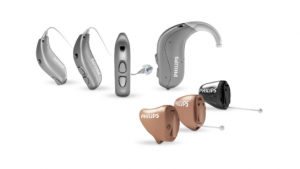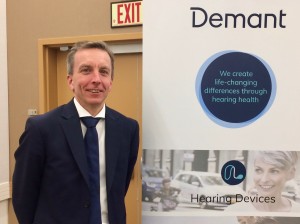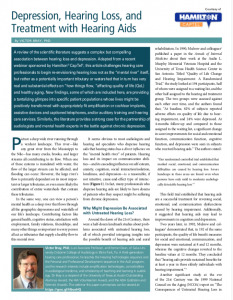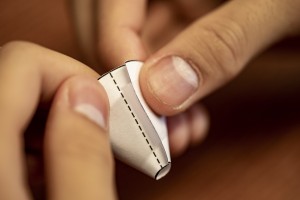Tech Topic | June 2019 Hearing Review
By Mark Sanford, AuD, and Lizz Jensen
One of the world’s foremost clinics that provide Lyric extended-wear hearing aids offers perspectives on its evolution and its potential to change a practice—as well as all hearing healthcare
Lyric, the first and currently only extended wear hearing device, was first fit commercially in January 2007 after 8 years of development. An article published in the April 2009 Hearing Review1 described candidacy, dispensing models, necessary equipment, scheduling, and a subsequent 2014 study looked at these same issues and compared Lyric 1 and 2 devices.2
Lyric has had multiple upgrades during the past 10 years from Lyric 1 to 2.1, 2.3, 3.0, 3.1, and 3.2. The effect of these upgrades have ranged from small to large. For example, a completely new chip in Lyric 3 changed Lyric from input compression to output compression. The changes in Lyric have improved the product, though there have been growing pains, as well as ups and downs during the past decade.
Lyric is dispensed in 14 countries on four continents, and there continues to be a opportunity for worldwide growth. Upgrades in product retention and the addition of two sizes in the past year now allow up to 91% of patients in our clinic to have a trial fitting with Lyric.
A Look Into the CSG Lyric User Base
Lyric is an excellent opportunity for providers willing to learn the skills of insertion and removal of the device, fit the product consistently, and to set themselves apart as a unique hearing specialist in their community. There are patients who have been paying over $3,000+/year for 10 years to wear Lyric bilaterally. This indicates these patients preference and desire to have a hearing product that allows 24/7 hearing functionality, as well as convenience, ease of use, cosmetic invisibility, natural sounds without occlusion, and does not remind them of their hearing loss at least two times/day as daily-wear devices will.
In this article, we present updated data on our experience with Lyric, how it has continued to change our business, our knowledge of related ear and skin health, and how our patients’ preferences continue to drive new business.
Demographics
The following data is based on 2,481 ears fit with Lyric. Since 2012, 80% of patients were fit binaurally and 20% monaurally.
Age. From 2012-2016, the average age for Lyric users was 74.9 years (Figure 1), while our practices’ daily-wear devices users is 69 years of age and has increased from 66 years in 1996. Considering Lyric was the first completely invisible device in the hearing industry—which some thought would attract younger users—this seems counter intuitive. We have fit many patients in their 90s, and more than 20 patients over 100 years of age with Lyric. The excellent sound quality, ease of use, not having to change batteries, not misplacing or losing device(s), hearing 24/7, normal telephone answering, and potential improvement in brain health are many of the reasons patients choose Lyric.
![Figure 1. Average age and percentage of males and females of Lyric users at CSG Better Hearing Centers, 2012-2016 (n=2481 ears).]()
Figure 1. Average age and percentage of males and females of Lyric users at CSG Better Hearing Centers, 2012-2016 (n=2481 ears).
The average age of 74.9 years of Lyric users provides a unique awareness of being a Lyric provider. Older patients tend to have more physician visits, surgeries, and scans (eg, MRIs) where Lyric will be discussed by other medical professionals who may not know Lyric exists. One family care physician told a patient, “I have 10 patients who are happy with their hearing aids and they all wear Lyric. The others aren’t happy. Go and get fit with Lyric.”
We have also fit teenagers as young as 13, as well as adults in every decade of life. People younger than age 60 prefer Lyric for all the same reasons as our older adults, with some bias towards cosmetics and the ability to partake in sports without worrying about their hearing device.
Gender. The percentage of males wearing Lyric ranged from 52-55%, and females 45-48% during this 5-year study period (2012-16), with an average of 53.3% male and 46.7% female (Figure 1).
New Patients
Trial success rates. A major source of new patients wanting to try Lyric is referral and word of mouth from family or friends of existing users. But it should also be pointed out that many who tried Lyric unsuccessfully still recommended Lyric to their family and friends.
The number of patients who want to try Lyric has not decreased over time. In fact, patients who tried Lyric in the past unsuccessfully have been refit successfully due to improvements in audiologist skills and knowledge as well as product improvements. For example, Lyric 1 was 16 mm long, and Lyric 2.1-3.2 was 12 mm (25% shorter) and narrower in design. With the five size options in Lyric 1, we could fit 54% of ears. When Lyric 2.1 was introduced, we increased the fit percentage to 85%. Today, with the seven sizes of Lyric 3.2, we are able to fit 91% of ears.
Fitting an ear with Lyric for a trial is not the same thing as a successful fitting of Lyric, where a patient opts to subscribe for the product and service. The number of ears fit with Lyric and the eventual number of Lyrics that a patient subscribes is called the trial to subscription rate or trial success rate (TSR). Our TSR has continually improved from 41% to 59% from 2012-2016, as shown in Figure 2. Improved audiologists’ skills and product improvements are the main reasons for this improvement.
![Figure 2. Percentage average renewal rate (gray line), trial success rate (blue line), and those patients who exchanged their Lyric hearing aids for daily-wear/traditional hearing aids (orange line), 2012-2016.]()
Figure 2. Percentage average renewal rate (gray line), trial success rate (blue line), and those patients who exchanged their Lyric hearing aids for daily-wear/traditional hearing aids (orange line), 2012-2016.
Opting for traditional hearing aids. The number of patients who try Lyric unsuccessfully and then change into a daily wear device varies from year to year, as shown by the orange line in Figure 2. The range from 5% to 20% is broad, with an average of 10.2% during the 5 year period. Often, patients who have been wearing daily-wear devices for many years realize their device(s) are becoming outdated and they are ready to try something new. They may try Lyric unsuccessfully and return to daily-wear devices. There are also Lyric patients who wear Lyric for a number of years who then change to daily-wear devices due to severity of hearing loss, financial reasons, or ear health issues.
Increasingly, new patients who come to our office know of Lyric and want to try it first to see if it can work for them versus a daily-wear device. Of these, a total of 61% of our patients who could be fit with Lyric ended up becoming users of the product/service, while 39% chose daily wear devices. Patients and their family members chose Lyric for the reasons mentioned above, with natural and excellent sound quality being the primary reason and the 24/7 hearing/convenience a close second.
Lyric as a loaner device. One option for a new patient who wants to try custom daily-wear devices or a receiver-in-the-ear (RITE/RIC) device with a custom mold is to be fit with Lyric while the new device(s) are being made. These patients’ transition to daily-wear devices is made easier by hearing sounds 24/7 for 1-2 weeks before being fit with their traditional aids. Another provider option is to size and fit Lyric for a patient whose daily-wear device is being repaired. This allows a patient to try Lyric in their daily life and compare the differences. Although most patients retain their daily-wear devices, they often tell others about Lyric. Some subscribe to Lyric, then use their repaired hearing aid as a backup.
Monaural Lyric users. Although the benefits of binaural hearing are well documented, we do have Lyric subscribers who use Lyric in one ear for 45-60 days and then switch to the opposite ear for the next period of time. This may be due financial reasons or ear and skin health issues. We also have subscribers who use Lyric on one side and a daily-wear device on the other due to asymmetrical hearing loss or ear and skin health issues on one side. This may also allow for a “best of both worlds” type of option in the selection process: the 24/7 hearing benefit of Lyric, combined with wireless connectivity, noise reduction, directionality, etc.
Renewals and Non-renewals
Renewals. Patients who renew their yearly Lyric subscriptions represent recurring revenue, adding greater stability for a business. Additionally, renewals cause satisfied Lyric users to become “cheerleader advocates” for the business, increasing referrals and new patients—some of whom in turn choose Lyric, while others choose daily-wear devices.
A key metric to track is the renewal rate, as well as the number of Lyric users who then change to a daily-wear device (Figure 2). Our renewal rate has been 78-90% during the 5 years studied, with an average of 85%. Patients who chose not to renew did so because they elected to wear a traditional device (10%), passed away (3%), or moved away (2%).
Figure 2 also shows the percentage of our patients who convert from Lyric users to daily-wear users each year. Understanding this, we can calculate renewal rates and know that approximately 10% will be making this conversion each year. Therefore, this is budgeted into our business (ie, business growth of 10% in hearing aid purchasers minus the loss in Lyric revenue subscriptions).
Non-renewals. Figure 3 shows the reasons patients do not renew their subscriptions at some point after using Lyric for at least one year. The Top-4 reasons why patients do not renew their Lyric subscription are: 1) Preference for a different hearing device (32%); 2) Discomfort (25.4%); 3) Feedback (10.2%), and 4) Death (13.4%). Other reasons patients do not renew their subscriptions include: the patient moved (8.5%), too expensive (5.1%), medical issues (2.3%), occlusion (2.3%), and migration in ear canal (0.1%).
![Figure 3. Reasons for non-renewals of Lyric subscriptions in the clinic during the 5-year study period (2012-2016).]()
Figure 3. Reasons for non-renewals of Lyric subscriptions in the clinic during the 5-year study period (2012-2016).
Marketing Lyric and Practice Differentiation
From the beginning, Lyric marketing has been proven to attract new patients with hearing loss—people who have never worn a hearing device, as well as current hearing aid users from our own and competitors’ practices. Many new patients make comments like “I don’t want to wear a traditional hearing aid, but I would like to try Lyric.” It is amazing (and disconcerting) to see people of all ages, particularly professionals, who have obviously struggled with significant hearing loss for years—and should be daily-wear device users—who will come in to try Lyric only. For whatever reason (eg, stigma, denial, convenience), it appears to be an option that breaks down barriers in resisting audiological hearing help.
In general, existing daily-wear device users try Lyric to see if they can hear better and to experience 24/7 hearing. Many are surprised by the excellent sound quality, convenience of not having to insert/remove the devices or batteries, as well as hearing their spouse or children/grandchildren, pets, phone, or alarm at any time during the night. Perhaps UK Audiologist Rob Davies said it best: “Lyric patients are not reminded of their hearing loss every day as daily wear users are at a minimum two times a day.”
Our experience has been that Lyric marketing via direct mail, newspaper, website, or other digital media has always had better response rates than daily-wear devices. Lyric is a specialized product that offers the cosmetics of an IIC, but is the only device that can offer 24/7 functionality. In marketing it comes across as something completely different than daily-wear devices.
In this respect, Lyric marketing is a differentiator, setting a business apart from competitors—and requiring skills that are truly different from most hearing aid dispensing offices and all big-box, online, or mass merchandisers. For those familiar with the tenets proposed in Jim Collin’s book Good to Great, Lyric providers offer something patients with hearing loss want and the competition doesn’t.
Our mindset on Lyric was stated best by audiologist Helena Solodar, AuD, of Audiological Consultants in Atlanta: “Every patient is a Lyric candidate until proven otherwise.” 2 This perspective ensures that patients know we “give it our all” to make Lyric work for them (and not lure them into our practice to provide another device). If they came to us with an interest in Lyric, it is our duty to try to make that happen safely for them, if possible, during a trial period. This may mean trying different sizes, determining how many days a patient initially should have Lyric in the ear before a refit, and seeing patients for multiple programming adjustments.
Ear Health and Skin Issues
A provider fitting Lyric has to use all their clinical skills and learn new ones not taught in graduate audiology courses. These skills include using a microscope or head loupes, having soft or “non-brick” hands for the gentle insertion and removal of the device, identifying patients who are good candidates, and being knowledgeable about ear/skin health issues of patients. Clinicians who fit Lyric also must also be knowledgeable about ear anatomy in the deeper part of the ear canal, the angle of the tympanic membrane, the bony cartilaginous juncture, humidity in the ear, skin health, and its optimal placement. All of these factors together determine if a patient can become a successful user and what the patient’s experience with Lyric will be like.
Patients’ skin ranges from very dry or “Sahara”-like (ie, lower humidity levels translating into longer days of wear of Lyric) on one end of the scale to wet, oily, or “rainforest”-like (ie, higher humidity levels translating into shorter days of wear). Patient skin health can be effected by certain drugs, such as blood thinners, chemotherapy and or radiation treatments (past or present), and other illnesses or chronic conditions (eg, diabetes). These issues influence how Lyric works for each patient and the clinician must be willing to learn how best to treat these patients as individuals.
Although our patients average 70 days of wearing time per device, the range of wear time is large. There are patients we schedule for replacement every 30-45 days, because that is what their ear/skin health can tolerate; other patients can wear Lyric for 60, 75, 90 days, or longer. The lifestyle of the patient and the climate can also affect the ear health and longevity of Lyric. Wet climates and activities can negatively affect service life.
Ear health issues decreased significantly from Lyric 1 to Lyric 2.1-3.2. The bony cartilaginous juncture in some ears with Lyric 1 was a problem,2 causing bony erosions to occur more frequently than today. The shorter, narrower versions (Lyric 2.1, 2.3, 3.1, 3.2, and 3.3) have nearly eliminated this issue which occurs less than 0.5% of the time in our clinics (Figure 3). Nevertheless, a Lyric provider must have an excellent ENT referral source in the rare case of a patient with a bony erosion or other significant ear health issue.
The majority of health issues (eg, pain, discomfort, moisture accumulation, blisters) are resolved with time and a break from use. Depending on the ear health issue, most resolve in 1-7 days with the Lyric absent from the canal. After this short healing period, Lyric can usually be worn successfully again by the patient. Even patients who have used Lyric for years can start to have a skin or ear health issue for a period of time, which usually then stops as quickly as it appeared. In our practice, less than 1% of Lyric subscribers who do not renew are due to ear health issues.
Future Possibilities
A recent study by Biggins et al described the mental health benefits of Lyric users.3 We have seen patients diagnosed with early dementia or Alzheimer’s disease start to wear Lyric and then are reassessed to find their cognitive decline was not as severe as previously though or even misdiagnosed.
Lyric is a unique device that, for most of our clinical population, supplies continuous stimulation to the auditory system and brain. Although we stress there is no scientific evidence, we believe the hearing system and brain adaptation period is faster with Lyric since it is worn 24/7. Over 80% of our patients are not turning Lyric into sleep mode or off at night. This means these patients are constantly receiving stimulation all day, everyday, compared to daily-wear users who use their devices 2-16 hours per day. Our hope is that a future study examines Lyric usage and dementia along the same lines as studies undertaken by Frank Lin and colleagues.4
We are beginning a new study that may allow more patients to use Lyric successfully by removal and self-insertion, which has helped solve a number of ear health issues for our existing Lyric users. It has also increased Lyric’s longevity for some patients, and allowed users to scuba dive and partake in other activities.
A decade after its introduction, Lyric continues to improve and be a solution for many patients with hearing loss. We have over 1,100 ears subscribing to Lyric in our 5 locations, with some patients using the technology for 10 years. For an industry that changes people’s life every day by improving their communication ability with family, friends, and co-workers, it is unfortunate that Lyric is under-utilized around the world. The good news is that Lyric, after 10 years, keeps evolving and the opportunity for growth remains massive.
![Screen Shot 2019-05-21 at 11.07.41 AM]()
Mark Sanford, AuD, is President of CSG Better Hearing Centers with five private-practice offices in the San Francisco Bay Area and is an Editorial Advisory Board member of Hearing Review. Lizz Jensen, is a librarian at Carmel Harrison Memorial Library in Carmel, Cal, and has worked on research projects collecting and analyzing data for CSG for several years.
Correspondence can be addressed to Dr Sanford at: csgbetterhearing@nullaol.com
Citation for this article: Sanford M, Jensen L. Lyric after 10 Years: New data and perspectives from a private practice. Hearing Review. 2019;26(6):26-28.
References
-
Arbogast T, Whichard S. A new hearing aid class: The first 100% invisible extended-wear hearing aid. Hearing Review. 2009;16(4):20-27.
-
Sanford MJ, Anderson T, Sanford C. The extended-wear hearing device: Observations on patient experiences and its integration into a practice. Hearing Review.2014;21(3): 26-31.
-
Biggins A, Singh G, Solodar H. Lyric shows significant psychosocial benefits. Phonak. https://www.phonakpro.com/content/dam/phonakpro/gc_hq/en/resources/evidence/field_studies/documents/fsn_lyric_psychosocial_benefits.pdf. August 2017.
-
Lin FR, Metter EJ, O’Brien RJ, Resnick SM, Zonderman AB, Ferrucci L. Hearing loss and incident dementia. JAMA Neurology. 2011;68(2):214-220.
 Demant, Copenhagen, Denmark, has announced the introduction of Philips branded hearing aids to the global hearing aid market, according to a press release from the company. A new player, the Philips brand is entering the hearing healthcare market with a complete range of premium hearing aids, accessories, and applications to best serve hearing aid users. Demant states Philips Hearing Solutions will quickly become a trusted brand with hearing care providers and users, as it has great potential around the world to present unique opportunities for hearing care professionals in an ever-evolving market.
Demant, Copenhagen, Denmark, has announced the introduction of Philips branded hearing aids to the global hearing aid market, according to a press release from the company. A new player, the Philips brand is entering the hearing healthcare market with a complete range of premium hearing aids, accessories, and applications to best serve hearing aid users. Demant states Philips Hearing Solutions will quickly become a trusted brand with hearing care providers and users, as it has great potential around the world to present unique opportunities for hearing care professionals in an ever-evolving market.






































